When Volkswagen of America selected us to build a Beetle for the 2012 SEMA Show we had no idea the massive task we'd undertaken.
By now you're familiar with our surf-themed SoCal Beetle we built for the occasion after it was featured in EC 4/13 issue. As good as it looked, it also needed to perform because we didn't want to build a Beetle with all show and no go. We were looking for high performance without any concessions, so we teamed up with our friends at Revo Technik.
 |
Revo Technik spent countless hours testing its products at Summit Point to ensure throttle response, braking and cornering were optimized
|
Revo Technik spent countless hours testing its products at Summit Point to ensure throttle response, braking and cornering were optimized
Not long ago the prospect of a 400hp VW on pump gas was just a notion rather than a reality. Eclipsing even 300hp would have required massive boost, race gas, a built motor and would have been an uncivilized beast. But a great deal has changed in recent watercooled history, with both VW and aftermarket tuners producing reliable and powerful engines.
Little did VW know what it started when creating the 1.8T motor back in 1996, laying the groundwork for the later 2.0T FSI and current TSI.
Blessed with direct injection, a stout bottom-end, high-flowing 16v head and backed by sophisticated electronics, the 2.0T is as mighty as it is tunable. Although it displaces a mere two-liters, a handful of key mods will see it to 350 or even 400hp and beyond.
As we mentioned earlier, we wanted power without any compromise, so wouldn't accept power spikes, surges, a lumpy idle or or unreliability.
It had to be the proverbial velvet hammer and thankfully Revo Technik unearthed some solutions to answer our questions.
Engine
Our first requirement was serious power and Revo's big-turbo kit blessed us with 375hp. Since our car would be center stage, we opted for a few more pounds of boost and high-octane fuel to reach 400hp for SEMA, but have since turned it back to the production 375hp for daily driving duties.
You might imagine it would take extraordinary measures but the affordable kit retails for just $2495 and improved our dyno figures by 157hp at 6100rpm and 164 lb-ft at 4300rpm without expensive modifications to the fuel system. The Revo K04 kit comes with everything needed to make big power without needing a new fuel pump, lines or rails.
The heart of the kit is a K04 turbo without its internal baffle for improved throttle response. Revo goes one step further and machines the compressor housing to accept VW's internal diverter valve, so it works like a factory K04. It also bolts directly to the stock downpipe and is supplied with Revo's renowned software to ensure smooth power delivery.
While the big-turbo kit would have been sufficient, we were going big so also specified the Revo SPS module that would allow us to switch between different boost and fuel maps.
Mechanically, there's Revo's cold-air intake to help the K04 ingest more air, which is chilled by a Eurojet front-mount intercooler to improve flow and avoid heat-soak.
The stout FMIC is a bolt-on part constructed from T5052 and T6061 aluminum with TIG-welded cast end-tanks. The core measures a colossal 23.5x2x16.5" and uses a bar and plate core design with a proprietary internal louver and fin setup to promote efficient chamber balance.
From the driver's seat, cooler and more consistent inlet charge temps means more power. In fact, Eurojet claims the charge remains within 2-6°F of ambient temperature, making it a worthwhile addition.
With so much work on the inlet, it was predictable that we'd de-restrict the outlet with a free-flowing Revo turbo-back exhaust. Designed for the Mk6 GTI, the 3" mandrel-bent system is built from brushed T304 stainless steel with a 0.065" wall thickness and uses modular V-band joints.
The thick wall construction avoids exhaust drone by retaining the sound inside the pipe, and is durable enough to merit a lifetime warranty. Furthermore, the V-band clamps feature self-aligning male and female ends for precise alignment and fit. This makes swapping out the cat-equipped mid-pipe for a race pipe a simple 10min operation.
Larger K04 turbo significantly increases power and torque without expensive fuel system upgrades but with OEM drivability.
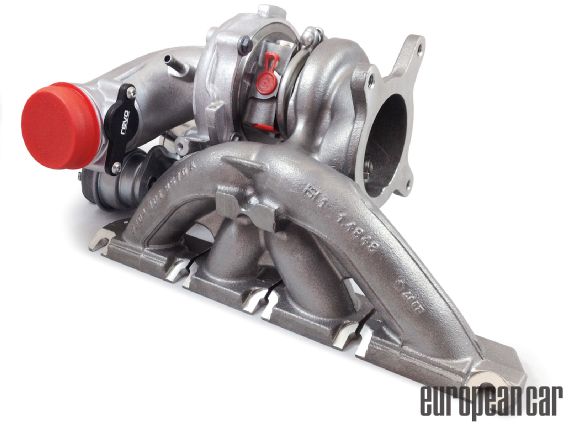 |
02 KO4 Turbo
|
02 KO4 Turbo
Revo SPS device allows user to switch between software maps. Ours has stock, "chipped" and race-gas maps installed
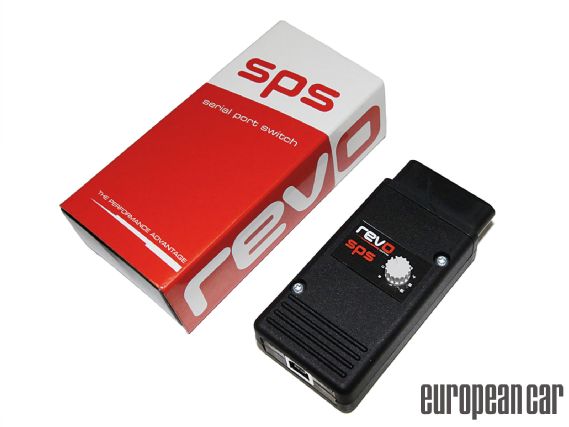 |
03 Revo SPS Device
|
03 Revo SPS Device
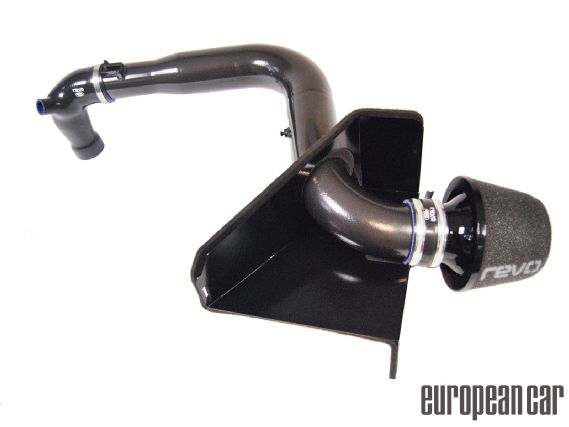 | 04 Revo Cold Air Intake
| 04 Revo Cold Air Intake
Revo cold-air intake increases power by allowing better airflow. It also sounds pretty good
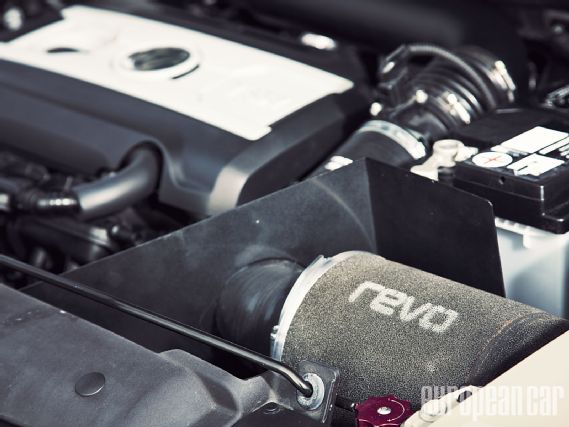 |
05 Revo Cold Air Intake
|
05 Revo Cold Air Intake
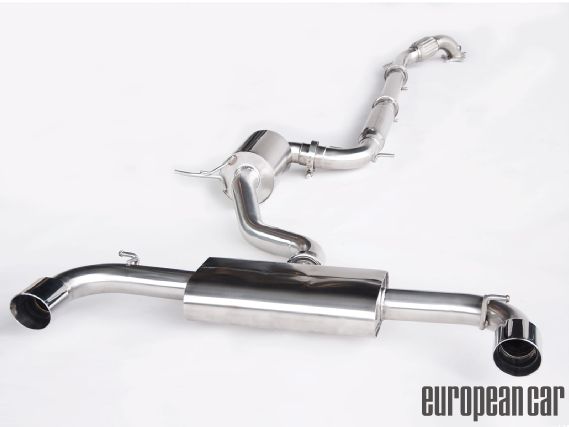 | 06 Revo Stainless Steel Exhaust
| 06 Revo Stainless Steel Exhaust
Revo's stainless steel 3" turbo-back exhaust boasts V-band clamps, thick-wall pipe and high-flow to increase power and produce a great note.
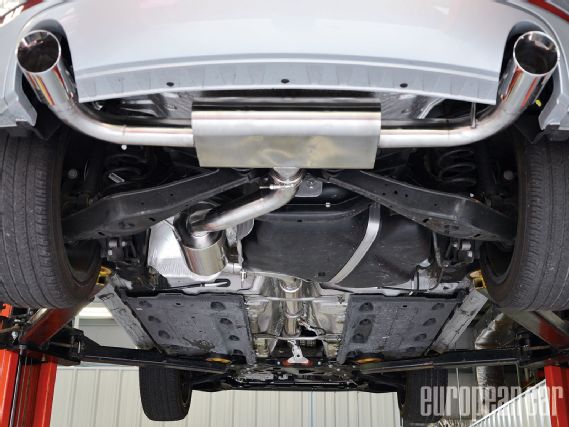 |
07 Revo Stainless Steel Exhaust
|
07 Revo Stainless Steel Exhaust
Chassis
Our big turbo certainly justified big brakes, and fortunately Revo had its 355 four-piston brake kit available. Borrowing technology from its racing partners at Stasis Engineering, the 355 kit uses deep-core cast Alcon monobloc calipers that are far stiffer than stock units and won't flex like regular two-piece units.
The kit's name is derived from the 355mm two-piece rotors that allow for 0.030" of axial and 0.040" of radial expansion in either direction. The Alcon Serofoil rotors have two pick-up points and are made from high nickel and copper content for heat dissipation and pad performance.
If you're thinking the four-piston calipers are off-the-shelf units, think again. Revo had the calipers built to their specifications for piston size, travel and bias. So they were tailored to the Mk6 chassis, not borrowed from an Audi or Porsche and retrofitted to your Volkswagen.
We wouldn't leave Revo's HQ in Summit Point, WV without proper suspension components to complete the mechanical transformation.
The plan originally involved prototype Revo units but these were later swapped to Eibach Multi-Pro-R2 coilovers with ten-way adjustable remote reservoirs. These feature independent rebound and compression settings, large 46mm pistons, and allow 0.80-2.5" of suspension lowering.
The remote reservoir design is a motorsport concept that allows the dampers to have greater oil capacity and can be mounted away from the units. The idea is to maintain consistent performance by avoiding heat build-up. When dampers are worked hard, the movement generates heat that aerates the oil, causing it to foam and work less effectively. By having a larger volume of oil, this is less likely to happen. And by mounting the reservoir remotely, it's away from the heat source and should remain cooler.
Having a completely flexible system was part of the plan since we wanted the Surf bug to be capable of everything from daily driving to track events, maybe drag racing, and it had to get to the beach when the need arose. So while the Revo team spent hours on the Summit Point racetrack dialing in the dampers and ride height, we simply slammed it for SEMA, but have subsequently returned it to the optimum settings. That explains why it sat low in EC 4/12 but slightly higher in EC 5/12 when we gathered all the SEMA Beetles together for our special article.
Revo's 355 brake kit uses 355mm Alcon two-piece rotors and custom one-piece Alcon monobloc calipers designed for Mk6 applications
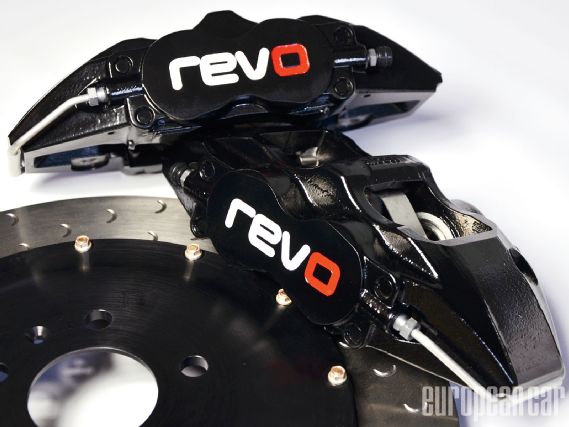 |
08 Revo 355 Brake Kit
|
08 Revo 355 Brake Kit
Remove reservoirs, ten-way adjustment for independent rebound and compression and an affordable price identify the Eibach Multi-Pro-R2 coilovers
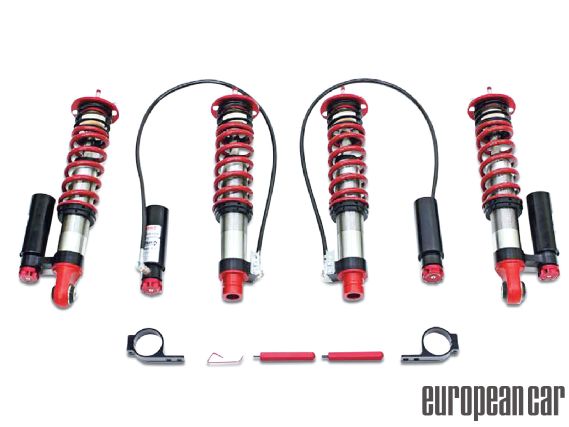 |
09 Eibach Multi Pro R2 Coilovers
|
09 Eibach Multi Pro R2 Coilovers
Driving
Sadly our time behind the wheel of the Surf Beetle has been limited, but we can safely say the brief moments have been jaw dropping.
Power from the K04 comes on early and hard. In fact, it'll spin the tires in the lower gears with the traction control switched off - driving with TC on is a frustrating exercise we try to avoid.
Shenanigans aside, increased thrust is most apparent in passing situations, where third gear is devoured instantly. We'd be lying if we didn't admit to baiting other drivers who see the roof rack and retro paint and don't assume this Bug will eat them alive! Outright power is only half the equation, because throttle response is much improved and the power curve is smooth from idle to redline. Thankfully, fuel consumption is generally unaffected if you can stay away from wide-open throttle. But the sound from the turbo and full exhaust beg to be heard often. This is no fart-can Honda; the Beetle sings baritone, with its deep note accompanied by angry rushes and swooshes escaping from under the hood.
The suspension and brakes also have a big impact, scrubbing speed and holding a turn with ease. There's no fade, shudder or squeal from the Alcon parts, but since we use the left pedal on our DSG car so late and hard, we're constantly cleaning our 19" Fuchs Performance wheels.
The Eibach coilovers bring out the inner racer in us but a few clicks of the adjuster allow the ride to be softened for the commute home. Admittedly, this Beetle isn't really set-up to maximize the ability of these units, but it was a good investment if we should ever decided to reassign the car to track duties in the future. But in their current role, the coilovers not only help curb understeer, but expansion joints and potholes aren't bone-jarring, which was a welcome discovery.
We strive for form and function in every car we build, and thanks to the help of our build partners, and the great platform offered by the new VW Beetle, we've created a fun project that seems to be enjoyed by fellow travelers and anybody who gets behind the wheel. We set out to prove the Beetle is flexible and has the potential to entertain driving enthusiasts, and hopefully we've achieved that goal.
In a future issue we'll look at the cosmetic features that made our Surf Beetle stand out.
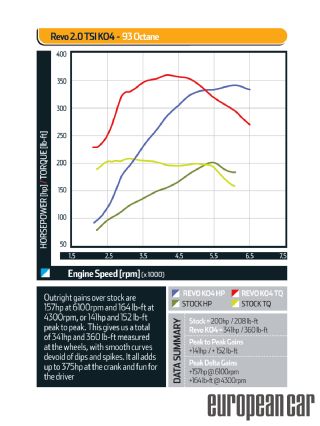 | 10 Volkswagen Beetle Turbo Dynograph
| 10 Volkswagen Beetle Turbo Dynograph

